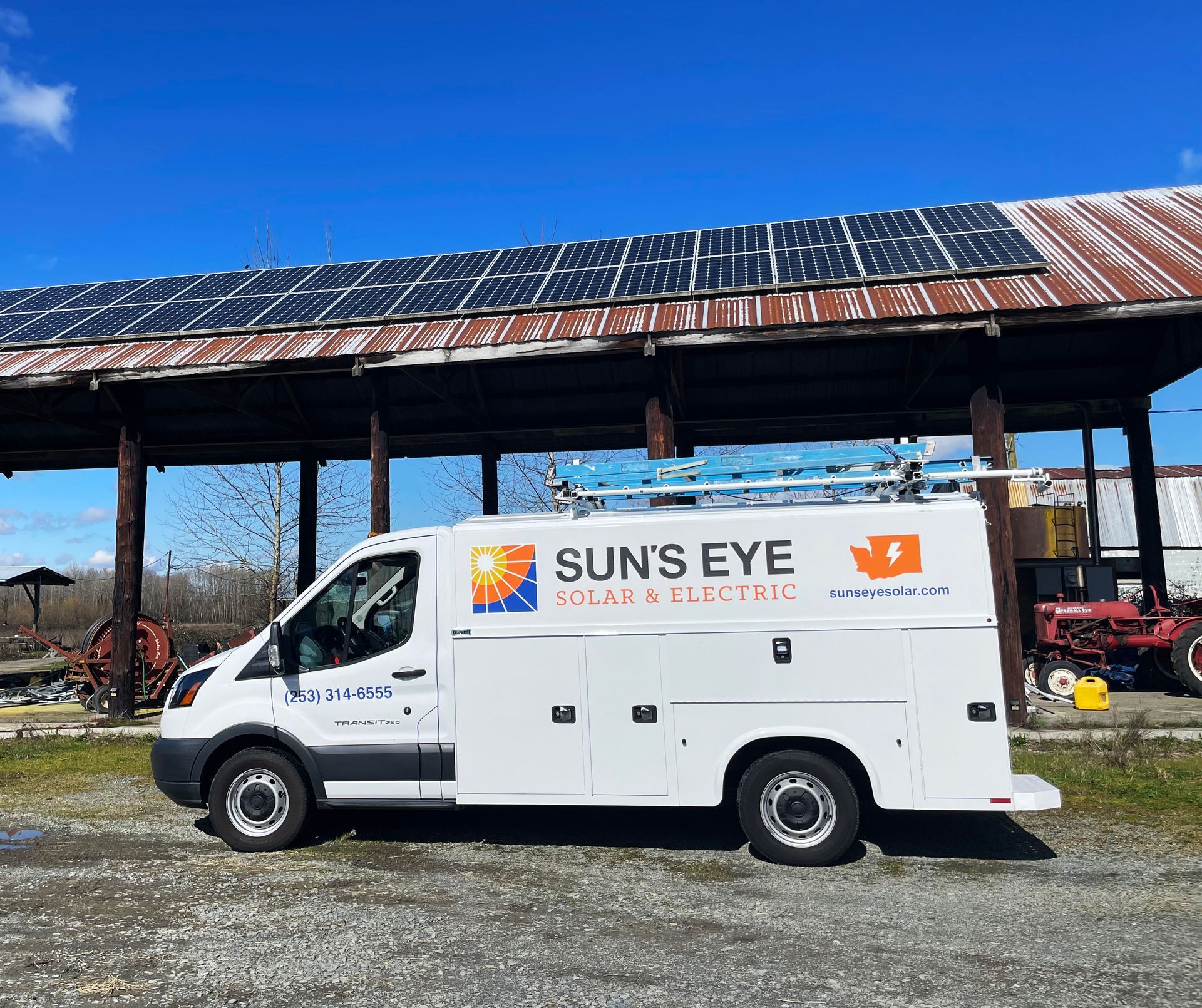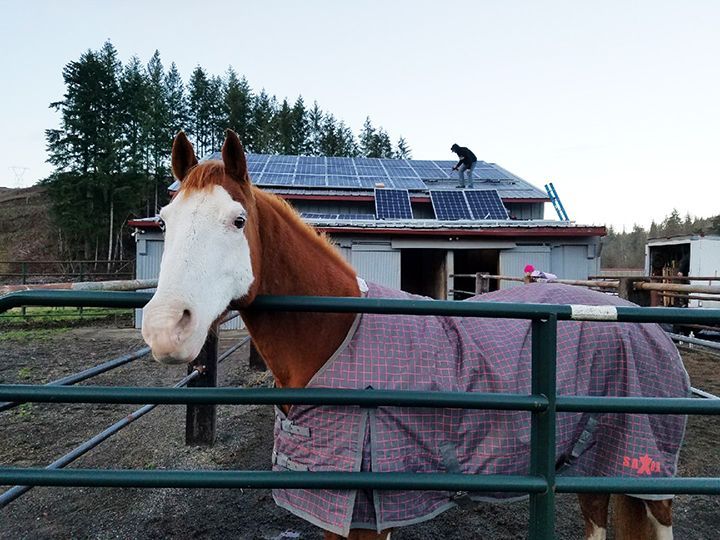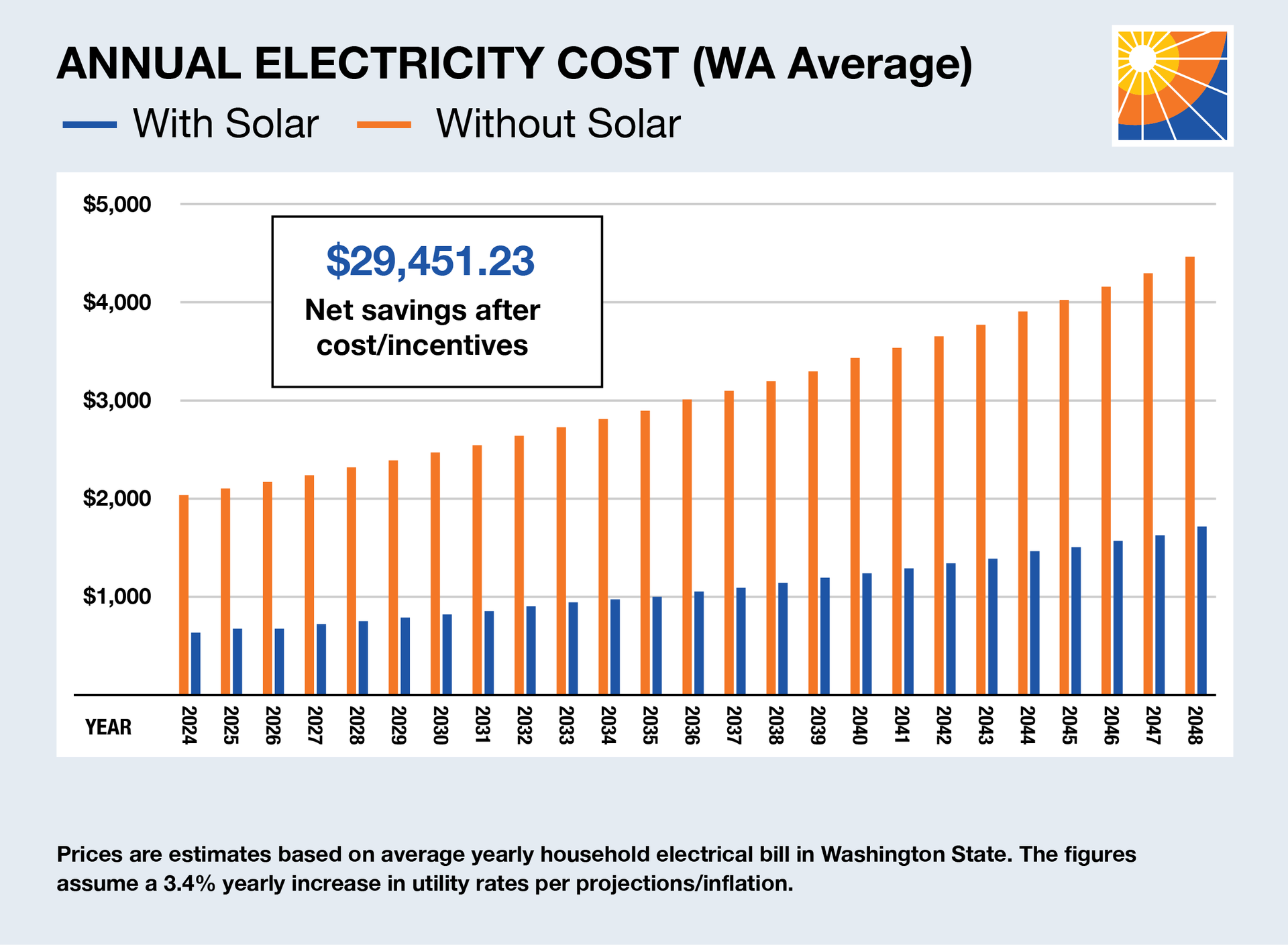Why Solar?
The Time to Make a Change is Now
Why Solar?
The Time to Make a Change is Now
Solar is Good for The Environment and Your Bank Account
Solar panels produce clean electricity without emitting harmful greenhouse gases, thereby reducing your carbon footprint and helping combat climate change. Generating your own renewable energy can significantly lower your electricity bills, providing long-term savings on energy costs. With advancements in technology and government incentives, the initial investment in solar panels can often be recouped relatively quickly, making it a financially savvy decision while also contributing to a sustainable future.

Solar is Good for The Environment and Your Bank Account
Solar panels produce clean electricity without emitting harmful greenhouse gases, thereby reducing your carbon footprint and helping combat climate change. Generating your own renewable energy can significantly lower your electricity bills, providing long-term savings on energy costs. With advancements in technology and government incentives, the initial investment in solar panels can often be recouped relatively quickly, making it a financially savvy decision while also contributing to a sustainable future.


Sustainability
We were drawn to working in solar by our deep love for nature and a desire to become better stewards of our planet. We see the task of helping our customers reduce their energy footprint as one that serves them, us, and our greater community as we are in the midst of a pivotal time regarding energy consumption and carbon emissions. Rapid popularization of renewable energy is essential to preserving life as we know it on this planet. Let us help you get started on your journey, today!

Sustainability
We were drawn to working in solar by our deep love for nature and a desire to become better stewards of our planet. We see the task of helping our customers reduce their energy footprint as one that serves them, us, and our greater community as we are in the midst of a pivotal time regarding energy consumption and carbon emissions. Rapid popularization of renewable energy is essential to preserving life as we know it on this planet. Let us help you get started on your journey, today!
Solar is an Investment that Pencils Out
Installing solar panels in Washington State offers attractive financial incentives for both homeowners and businesses. Through net metering programs, excess solar energy generated can be sold back to the grid, providing credits on utility bills. Additionally, Washington offers sales tax exemptions for solar energy systems, reducing upfront costs. Furthermore, the federal Investment Tax Credit (ITC) allows for a significant tax credit on solar installations, further decreasing the overall expense. These incentives, combined with the long-term savings on electricity bills and potential increases in property value, make solar installation a financially sound decision.

Solar is an Investment that Pencils Out
Installing solar panels in Washington State offers attractive financial incentives for both homeowners and businesses. Through net metering programs, excess solar energy generated can be sold back to the grid, providing credits on utility bills. Additionally, Washington offers sales tax exemptions for solar energy systems, reducing upfront costs. Furthermore, the federal Investment Tax Credit (ITC) allows for a significant tax credit on solar installations, further decreasing the overall expense. These incentives, combined with the long-term savings on electricity bills and potential increases in property value, make solar installation a financially sound decision.

Solar Investment by the Numbers
$99.45
Average amount saved
monthly on utility bill in WA
25-30 Years
Average lifespan of solar
panels.
16 Years
Average payback period on
solar investment in WA
2032
The Last Year to collect on
peak 30% federal tax credits
$99.45
Average amount
saved monthly on
utility bill in WA
25-30 Years
Average lifespan
of
solar panels.
16 Years
Average payback
period on
solar
investment in WA
2032
The Last Year to collect
on peak 30% federal
tax credits
Frequently Asked Questions
We're here to answer any of your questions regarding solar energy and government incentives.
-
How much will a solar panel installation cost for my home?
The cost of a solar panel installation for your home can vary widely depending on several factors, including the size and type of system, your location, the structure of your roof, and any additional components or features you may choose. It's essential to get a customized quote that addresses your specific needs. Various financing options, incentives, and rebates are available to help offset the initial cost and make solar energy more affordable for homeowners.
-
What is the expected payback period or return on investment (ROI) for installing solar panels?
The expected payback period or return on investment (ROI) for installing solar panels varies depending on factors such as the initial cost of the system, local electricity rates, available incentives, and energy usage patterns. On average, in Washington, homeowners can typically expect a payback period of around 12-16 years for their solar panel investment. After this initial payback period, solar panels continue to generate electricity and savings for many years, often exceeding 30 years or more. Over the lifespan of the system, homeowners can realize significant financial returns through reduced electricity bills, potential incentives such as net metering, and increased property value.
-
What incentives or rebates are available for solar installations, both at the federal and state levels?
At the federal level, the primary incentive is the Investment Tax Credit (ITC), which allows homeowners to deduct a percentage of the cost of their solar panel system from their federal taxes. As of 2023, the ITC provides a tax credit of 30% of the total cost of the solar installation. This tax credit will remain at 30% through 2032. The rate reduces to 26% in 2033, 22% in 2034, and phase out entirely in 2035, unless renewed.
Washington State offers a sales tax exemption, which exempts homeowners from paying sales tax on the purchase of solar panels and related equipment.
-
How do I connect my solar panels to the grid, and how does net metering work?
Connecting your solar panels to the grid involves installing a solar inverter to convert the panels' direct current (DC) electricity into usable alternating current (AC) electricity for your home. This AC output is then connected to your home's electrical panel, allowing solar-generated electricity to power your household appliances. Before connecting to the grid, you'll need to sign an interconnection agreement with your utility company, outlining the terms for feeding excess electricity back into the grid. Once connected, a bidirectional meter is installed to track both the electricity you consume from the grid and the excess electricity your solar panels send back, facilitating accurate billing and crediting through net metering.
Net metering is a billing arrangement that credits you for the excess electricity your solar panels produce and feed back into the grid. When your panels generate more electricity than your home consumes, you receive credits on your utility bill. These credits offset the cost of electricity you draw from the grid when your panels aren't producing enough, such as during the night or on cloudy days. At the end of each billing period, your utility reconciles your grid consumption with the excess electricity you've generated, potentially resulting in a credit or payment for any surplus electricity. Net metering enables you to maximize the financial benefits of your solar energy system by effectively offsetting your electricity costs and promoting grid stability through renewable energy integration.
-
How long does the installation process take?
The duration of the solar installation process can vary depending on factors such as the size of the system, complexity of the installation, permitting requirements, and weather conditions. On average, a residential solar panel installation typically takes between one to three days for the physical installation itself. However, the entire process, including initial consultation, design, permitting, and inspection, can take several weeks to a few months.
-
Will my home qualify for solar panels based on its location, roof orientation, and shading?
Location: Homes located in regions with ample sunlight, such as areas with minimal cloud cover or obstruction from tall buildings or trees, are typically well-suited for solar panels. However, solar energy can be viable in a wide range of locations, including those with moderate sunlight, depending on factors like panel efficiency and energy needs.
Roof orientation: South-facing roofs generally receive the most sunlight throughout the day, making them ideal for solar panel installations in the Northern Hemisphere. However, east- and west-facing roofs can also be suitable, albeit with slightly lower efficiency. North-facing roofs are generally less ideal but can still support solar panels, especially with the right tilt angle.
Shading: Shading from nearby trees, buildings, or other obstructions can impact the performance of solar panels. It's essential to assess potential shading issues and determine whether trimming trees or adjusting panel placement can mitigate shading effects. Additionally, shading analysis tools and advanced panel technologies, such as microinverters or optimizers, can help minimize the impact of shading on solar panel efficiency.
-
What type of warranties are offered for the solar panels and the installation work?
Solar panel warranties typically include two main components: equipment warranties and performance warranties. Equipment warranties cover defects in materials and workmanship for a specified period, typically ranging from 10 to 25 years, depending on the manufacturer. These warranties ensure that the solar panels themselves are free from defects and will continue to generate electricity within specified performance parameters.
Performance warranties guarantee that the solar panels will maintain a certain level of electricity production over time. Typically, performance warranties guarantee a certain level of output, such as 80% or 90% of the panel's rated output, over a specified period, often 25 years. If the panels fail to meet the guaranteed performance levels, the manufacturer will either repair or replace them.
-
What ongoing maintenance is required for solar panels, and how can I ensure optimal performance over time?
Solar panels require minimal ongoing maintenance to ensure optimal performance over time. Regular cleaning to remove dirt and debris, visual inspections for signs of damage, and monitoring system performance are the primary maintenance tasks. Additionally, managing shading and ensuring proper operation of the inverter are essential for maximizing efficiency. With these simple maintenance practices and periodic professional inspections, solar panel owners can enjoy reliable and efficient energy production for years to come, making solar panels a low-maintenance and hassle-free investment in clean, renewable energy.
-
How much will a solar panel installation cost for my home?
The cost of a solar panel installation for your home can vary widely depending on several factors, including the size and type of system, your location, the structure of your roof, and any additional components or features you may choose. It's essential to get a customized quote that addresses your specific needs. Various financing options, incentives, and rebates are available to help offset the initial cost and make solar energy more affordable for homeowners.
-
What is the expected payback period or return on investment (ROI) for installing solar panels?
The expected payback period or return on investment (ROI) for installing solar panels varies depending on factors such as the initial cost of the system, local electricity rates, available incentives, and energy usage patterns. On average, in Washington, homeowners can typically expect a payback period of around 12-16 years for their solar panel investment. After this initial payback period, solar panels continue to generate electricity and savings for many years, often exceeding 30 years or more. Over the lifespan of the system, homeowners can realize significant financial returns through reduced electricity bills, potential incentives such as net metering, and increased property value.
-
What incentives or rebates are available for solar installations, both at the federal and state levels?
At the federal level, the primary incentive is the Investment Tax Credit (ITC), which allows homeowners to deduct a percentage of the cost of their solar panel system from their federal taxes. As of 2023, the ITC provides a tax credit of 30% of the total cost of the solar installation. This tax credit will remain at 30% through 2032. The rate reduces to 26% in 2033, 22% in 2034, and phase out entirely in 2035, unless renewed.
Washington State offers a sales tax exemption, which exempts homeowners from paying sales tax on the purchase of solar panels and related equipment.
-
How do I connect my solar panels to the grid, and how does net metering work?
Connecting your solar panels to the grid involves installing a solar inverter to convert the panels' direct current (DC) electricity into usable alternating current (AC) electricity for your home. This AC output is then connected to your home's electrical panel, allowing solar-generated electricity to power your household appliances. Before connecting to the grid, you'll need to sign an interconnection agreement with your utility company, outlining the terms for feeding excess electricity back into the grid. Once connected, a bidirectional meter is installed to track both the electricity you consume from the grid and the excess electricity your solar panels send back, facilitating accurate billing and crediting through net metering.
Net metering is a billing arrangement that credits you for the excess electricity your solar panels produce and feed back into the grid. When your panels generate more electricity than your home consumes, you receive credits on your utility bill. These credits offset the cost of electricity you draw from the grid when your panels aren't producing enough, such as during the night or on cloudy days. At the end of each billing period, your utility reconciles your grid consumption with the excess electricity you've generated, potentially resulting in a credit or payment for any surplus electricity. Net metering enables you to maximize the financial benefits of your solar energy system by effectively offsetting your electricity costs and promoting grid stability through renewable energy integration.
-
How long does the installation process take?
The duration of the solar installation process can vary depending on factors such as the size of the system, complexity of the installation, permitting requirements, and weather conditions. On average, a residential solar panel installation typically takes between one to three days for the physical installation itself. However, the entire process, including initial consultation, design, permitting, and inspection, can take several weeks to a few months.
-
Will my home qualify for solar panels based on its location, roof orientation, and shading?
Location: Homes located in regions with ample sunlight, such as areas with minimal cloud cover or obstruction from tall buildings or trees, are typically well-suited for solar panels. However, solar energy can be viable in a wide range of locations, including those with moderate sunlight, depending on factors like panel efficiency and energy needs.
Roof orientation: South-facing roofs generally receive the most sunlight throughout the day, making them ideal for solar panel installations in the Northern Hemisphere. However, east- and west-facing roofs can also be suitable, albeit with slightly lower efficiency. North-facing roofs are generally less ideal but can still support solar panels, especially with the right tilt angle.
Shading: Shading from nearby trees, buildings, or other obstructions can impact the performance of solar panels. It's essential to assess potential shading issues and determine whether trimming trees or adjusting panel placement can mitigate shading effects. Additionally, shading analysis tools and advanced panel technologies, such as microinverters or optimizers, can help minimize the impact of shading on solar panel efficiency.
-
What type of warranties are offered for the solar panels and the installation work?
Solar panel warranties typically include two main components: equipment warranties and performance warranties. Equipment warranties cover defects in materials and workmanship for a specified period, typically ranging from 10 to 25 years, depending on the manufacturer. These warranties ensure that the solar panels themselves are free from defects and will continue to generate electricity within specified performance parameters.
Performance warranties guarantee that the solar panels will maintain a certain level of electricity production over time. Typically, performance warranties guarantee a certain level of output, such as 80% or 90% of the panel's rated output, over a specified period, often 25 years. If the panels fail to meet the guaranteed performance levels, the manufacturer will either repair or replace them.
-
What ongoing maintenance is required for solar panels, and how can I ensure optimal performance over time?
Solar panels require minimal ongoing maintenance to ensure optimal performance over time. Regular cleaning to remove dirt and debris, visual inspections for signs of damage, and monitoring system performance are the primary maintenance tasks. Additionally, managing shading and ensuring proper operation of the inverter are essential for maximizing efficiency. With these simple maintenance practices and periodic professional inspections, solar panel owners can enjoy reliable and efficient energy production for years to come, making solar panels a low-maintenance and hassle-free investment in clean, renewable energy.
Let’s talk about your project
Fill in the form or call to discuss your project at (253) 314-6555.
Thank you for contacting us. We will get back to you as soon as possible.
Let’s talk about your project
Fill in the form or call to discuss your project at (253) 314-6555.